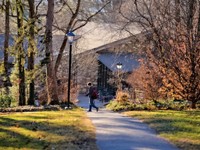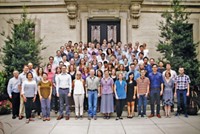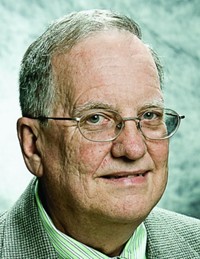Advertisement
Grab your lab coat. Let's get started
Welcome!
Welcome!
Create an account below to get 6 C&EN articles per month, receive newsletters and more - all free.
It seems this is your first time logging in online. Please enter the following information to continue.
As an ACS member you automatically get access to this site. All we need is few more details to create your reading experience.
Not you? Sign in with a different account.
Not you? Sign in with a different account.
ERROR 1
ERROR 1
ERROR 2
ERROR 2
ERROR 2
ERROR 2
ERROR 2
Password and Confirm password must match.
If you have an ACS member number, please enter it here so we can link this account to your membership. (optional)
ERROR 2
ACS values your privacy. By submitting your information, you are gaining access to C&EN and subscribing to our weekly newsletter. We use the information you provide to make your reading experience better, and we will never sell your data to third party members.
Education
Community Colleges
In a down economy, two-year colleges are a smart choice, but they struggle with overcrowding, scant funding
by Linda R. Raber
September 7, 2009
| A version of this story appeared in
Volume 87, Issue 36

Before a cheering crowd at Macomb Community College, in Warren, Mich., on July 14, President Barack Obama unveiled his American Graduation Initiative with this observation: “Community colleges are an undervalued asset in our country,” he said. “Not only is that not right, it’s not smart.”
Hard-hit by the nation’s economic recession and reeling from mass layoffs in the automobile industry, Michigan needs as much support as it can get in helping laid-off workers retrain for new careers. It also needs to steer its young people toward educational paths that will prepare them for careers in an economy that is driven less by heavy industry than by high-technology products and services—paths that require at least some college.
The need for high-quality, low-cost postsecondary education is not limited to Michigan. Enrollments are spiking at virtually all of the nation’s 1,045 community colleges, institutions that serve more than 45%, currently 11.5 million, of the nation’s college students. In addition to having low tuition costs, community colleges are open to any student with a high school diploma or equivalent and are convenient, usually within comfortable driving distances of their students’ homes.
With open enrollments come challenges that are seldom encountered at more traditional four-year institutions. Community college faculty are often called upon to fill daunting educational gaps left by high schools; to flexibly accommodate the needs of students who care for children or parents, are generally older than traditional college students, and may work full-time; and to educate new immigrants whose English-language skills prevent them from enrolling at other colleges. Community colleges are also the go-to institutions for displaced workers retraining for new jobs.
With most of their funding coming from their home states and, so far, little from the federal government, community colleges do all of these jobs year in and year out while charging an average of less than 25% of the cost of four-year state academic institutions—and more like one-tenth the cost of private four-year colleges. In the current economy, with money tight and the need for their services high, community colleges are being squeezed hard.
Onofrio (Dick) Gaglione is a 40-plus-year veteran chemistry professor who is retired from New York City College of Technology and is now adjunct professor at the College of Southern Nevada, in North Las Vegas. A keen observer of community colleges in general and of their chemistry programs in particular, he believes “the Obama Administration’s proposal to provide $12 billion to community colleges over the next 10 years is an explicit recognition that two-year colleges will play an important role in improving the economy.”
Mark Matthews, a chemistry professor at Durham Technical Community College’s campus in Durham, N.C., agrees that nothing is surprising about tight funding these days. “What makes it particularly challenging for two-year schools is that when the economy goes down, our enrollment traditionally goes up,” he explains. Only a few courses at Durham Tech aren’t filled to more than capacity this semester, Matthews tells C&EN. He’s teaching four sections of “Gen Chem I,” and all of them are filled beyond the normal cap.
Across the country, at Cabrillo College, in Santa Cruz, Calif., emeritus professor of chemistry Harry Ungar sees the same thing. “Many classes and sections have been cut, leading to long student waiting lists,” he says. He worries that “many students will not get the classes they need and their graduation will be delayed.”
Enrollments are soaring in the Deep South, too. Pamela Clevenger, a chemistry professor at Hinds Community College, in Raymond, Miss., says this year’s enrollment in chemistry courses is about 30% higher than one year ago; enrollment for the Raymond campus is up 17% overall.

Like their predecessors, students who are now flooding community colleges are doing so for a variety of reasons, but mainly for the lower cost. Jinyoung Kim, who recently came to the U.S. from South Korea, started college at Portland Community College (PCC), in Oregon, where he took general and organic chemistry courses before transferring to Oregon State University. He is starting his senior year at Oregon State and expects to attend pharmacy school when he receives his bachelor’s degree.
At PCC, “I had many options to attend classes at lower prices than at four-year institutions, and most of my credits transferred,” he tells C&EN. “I’ve seen many students who had no idea what they wanted,” he says, and who were “wasting their time and money while they were attending four-year institutions.” Kim believes community college students are much more focused.
Halima Ali is currently a sophomore at PCC. Ali came to Oregon from Kismaayo, Somalia, via Texas. She chose to study chemistry at PCC because “it’s the same material but less expensive for the course.” The college “is very friendly, and the classes have fewer students, and that means more time to communicate with your professor,” she says. She also likes the diversity of the student body. “It makes the school more interesting, and you get to learn about other students’ cultures and backgrounds,” she says.
With the diversity in community colleges also comes the frequent need for students to be brought up to speed for college-level courses. “Because of our open-door policy, we probably get a larger percentage of students who try to take introductory chemistry before they’re ready,” Matthews says, “but the ones who do meet the prerequisites for the course are usually just as bright and talented as students at a four-year school. Most of our students transfer to one of our area universities, and many times the only reason they didn’t start there as a freshman is cost.”
Stephen E. Hedrick, a visiting instructor in chemistry at New River Community & Technical College, in Beckley, W.Va., gets “every kind of student, but I mostly get people scared of chemistry,” he says. “Their secondary school education is lacking.” He believes that many of his students are intelligent but stopped learning with confidence sometime after elementary school. “They got through and graduated, but they are not confident and are totally afraid to make mistakes,” he says.
Most of Hedrick’s chemistry students aim for careers in medicine—usually nursing. “They are trying to stay on a fast path,” Hedrick says, which means graduating from the program, taking the national board exams, and going to work without a bachelor’s degree. “They and their families are ready to sacrifice a lot to get it done.”
Aspiring nurse anesthetist Stephanie Barnett is aiming for a bachelor’s degree but otherwise fits that description. A sophomore at PCC, she is a 31-year-old mother of two and has also attended Chemeketa Community College, in Salem, Ore. So far, her husband’s income has been paying for school, but she hopes to receive federal aid for low-income students in the form of a Pell Grant.
Although they are hoping the President’s funding for community colleges becomes reality, the community college chemistry professors C&EN contacted are not just sitting back and waiting. Some are applying for federal grants, something that community college faculty haven’t traditionally done. “Enrollment is up, so that increases the costs of supplying lab materials,” Clevenger says. “It is a challenge to maintain up-to-date instrumentation for student use. I realize that to keep my laboratories current, I need to actively seek grant funding and write quality proposals.”
Community college chemistry professor David R. Brown has been successful at securing funding for his school, Southwestern College, in Chula Vista, Calif. He received a grant several years ago from the National Science Foundation to purchase some “very nice analytical chemical instrumentation,” including an FTIR spectrophotometer, a GC/MS system, an NMR spectrometer, a UV-Vis spectrophotometer, and an HPLC system.
“This grant truly revolutionized the capability with which we are able to teach chemistry and undertake research and independent study projects with our students,” Brown says. He also received NSF funds to establish a new degree program in chemical technology at Southwestern. He is now helping his chemistry colleagues at the two-year college write grants that get funded.
With coprincipal investigators Jennifer Lewis from the University of South Florida, Melanie Cooper from Clemson University, and Iraj B. Nejad from Mount San Antonio College, Brown just finished running an NSF-supported one-and-a-half-day workshop on proposal preparation. They are currently following this up with mentoring to guide the 15 participants in preparing Course, Curriculum & Laboratory Improvement proposals to be submitted to NSF in the 2010 award competition. “The overarching goal is to increase the number of quality proposals NSF receives from two-year college chemists,” Brown says. “In recent years, that number has been very low.”
And the time is right to learn how to successfully chase the federal dime. The bulk of the funding called for in President Obama’s proposed American Graduation Initiative will flow to colleges in the form of competitive grants, so those with grant-writing skills will have an advantage over those who don’t.
According to the College of Southern Nevada’s Gaglione, some funding for two-year college chemistry education should come from professional societies like the American Chemical Society. The society currently provides funding through its ACS Scholars Program, which grants scholarships to underrepresented minority students (African American, Hispanic/Latino, and American Indian students) majoring in the chemical sciences. These awards, Gaglione believes, should remain “a key source of funds for two-year-college chemistry students.”
“The ACS Scholars Program has an exceptionally high success rate in assisting underrepresented minorities in achieving degrees in the chemical sciences from the A.S. to the Ph.D.,” Gaglione says. “Since the community colleges enroll a large percentage of underrepresented minorities throughout the nation, many of these awards will be available for those students who qualify academically.”
Obama’s repeated emphasis on community colleges and selection of Martha J. Kanter, former chancellor of the Foothill-De Anza Community College District, in California, as undersecretary of education, is gratifying to chemistry professors contacted by C&EN. They are hoping that this emphasis may be a turning point for these workhorse institutions, leading them to greater respect in the academic community and funding commensurate with the difficult job they do.





Join the conversation
Contact the reporter
Submit a Letter to the Editor for publication
Engage with us on Twitter